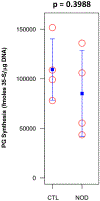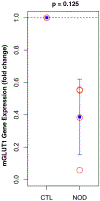The Role of Type I Diabetes in Intervertebral Disc Degeneration
- PMID: 30973512
- PMCID: PMC6697217
- DOI: 10.1097/BRS.0000000000003054
The Role of Type I Diabetes in Intervertebral Disc Degeneration
Abstract
Study design: An experimental laboratory study.
Objective: To investigate the pathogenesis of intervertebral disc degeneration (IDD) in a murine model of type 1 diabetes mellitus (DM), namely nonobese diabetic (NOD) mouse.
Summary of background data: IDD is a leading contributor of low back pain, which represents one of the most disabling symptoms within the adult population. DM is a chronic metabolic disease currently affecting one in 10 adults in the United States. It is associated with an increased risk of developing IDD, but the underlying process remains poorly understood.
Methods: Total disc glycosaminoglycan content, proteoglycan synthesis, aggrecan fragmentation, glucose transporter gene expression, and apoptosis were assessed in NOD mice and wild-type euglycemic control mice. Spinal structural and molecular changes were analyzed by micro-computed tomography, histological staining (Safranin-O and fast green), and quantitative immunofluorescence (anti-ADAMTS-4 and -5 antibodies).
Results: Compared with euglycemic controls, NOD mice showed increased disc apoptosis and matrix aggrecan fragmentation. Disc glycosaminoglycan content and histological features of NOD mice did not significantly differ from those of euglycemic littermates.
Conclusion: These data demonstrate that DM may contribute to IDD by increasing aggrecan degradation and promoting cell apoptosis, which may represent early indicators of the involvement of DM in the pathogenesis of IDD.
Level of evidence: N/A.
Figures







References
-
- Vadala G, Russo F, Ambrosio L, et al. Biotechnologies and Biomaterials in Spine Surgery. J Biol Regul Homeost Agents. 2015;29(4 Suppl):137–47. - PubMed
-
- Vadala G, Russo F, Di Martino A, et al. Intervertebral disc regeneration: from the degenerative cascade to molecular therapy and tissue engineering. J Tissue Eng Regen Med 2015;9(6):679–90. - PubMed
-
- Russo F, Hartman RA, Bell KM, et al. Biomechanical Evaluation of Transpedicular Nucleotomy With Intact Annulus Fibrosus. Spine (Phila Pa 1976). 2017;42(4):E193–E201. - PubMed
MeSH terms
Grants and funding
LinkOut - more resources
Full Text Sources
Medical
Research Materials

